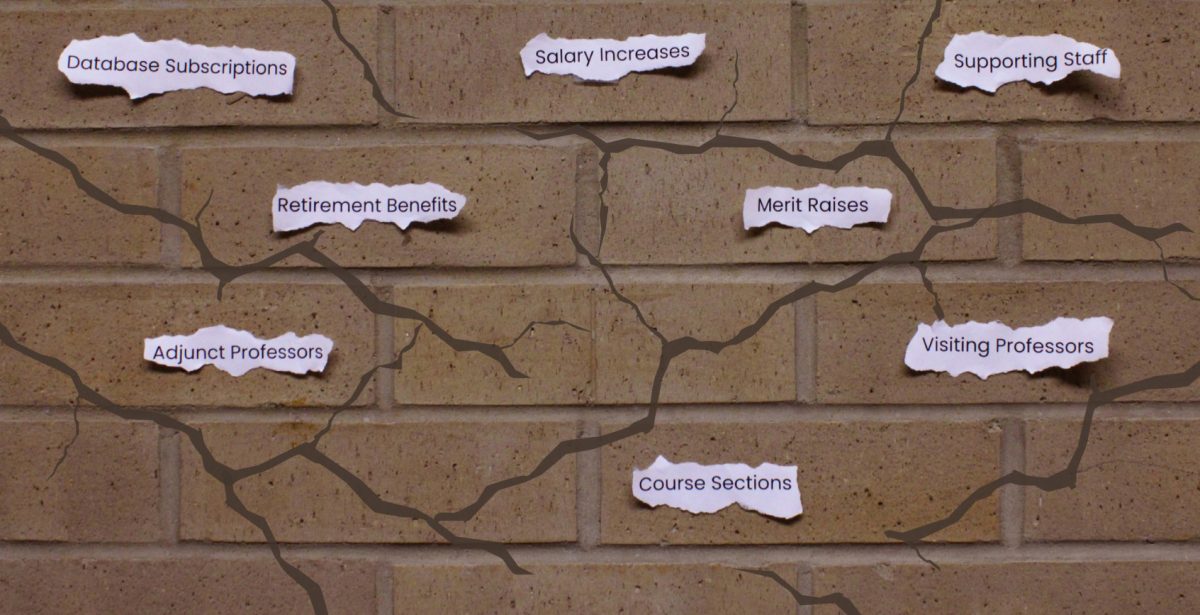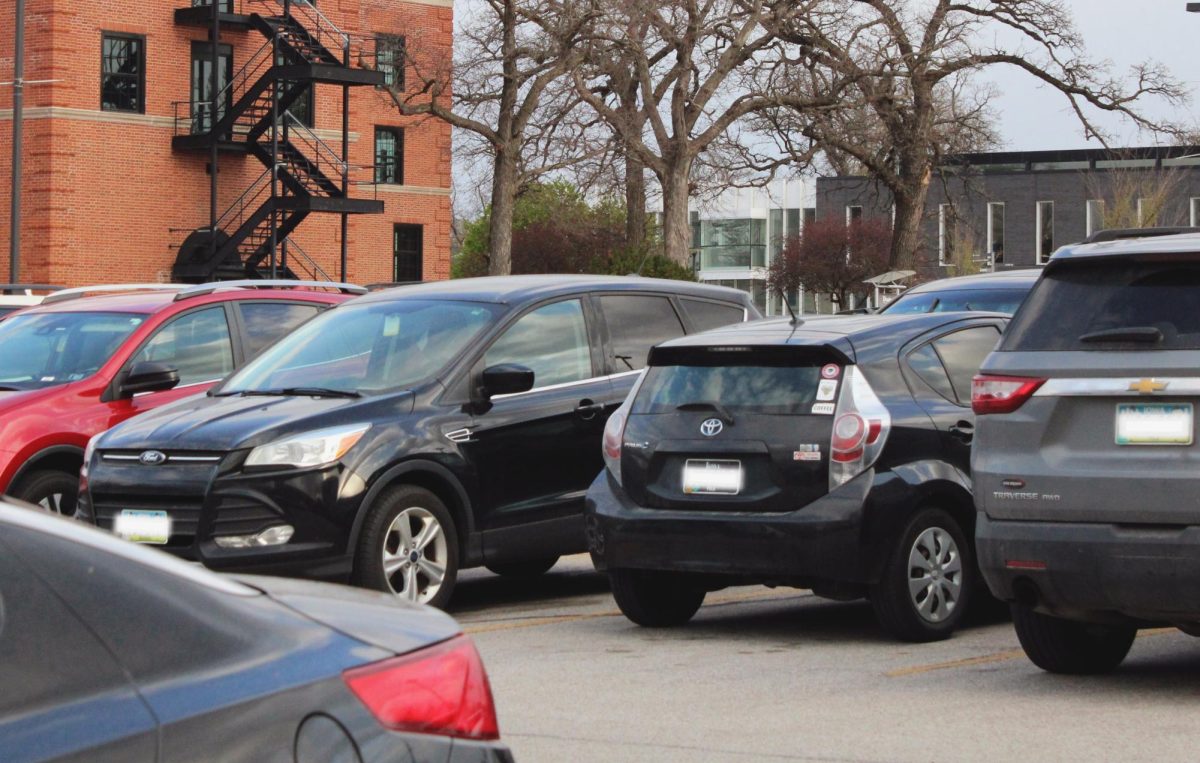In an effort to meet its goal of breaking even by fiscal year 2027, Drake reduced employee benefits starting this past July and is encouraging departments to streamline their operations.
Last spring, Faculty Senate voted against cutting six out of nine programs up for program review. In a March interview, Provost Sue Mattison said she “found the funds to make up the difference when the programs were not eliminated.” According to journalism professor Sandy Henry, Mattison was transparent with Faculty Senate that, if Senate voted down program cuts, Drake employees — including administration, faculty and staff — would see cuts to their benefits.
“We [Faculty Senate] made our own bed, and now we have to sleep in it,” Henry said. “Unfortunately, the staff didn’t make their own bed, and we’ve hauled them along for the ride.”
Drake administrators said the University’s budget challenges stem from years of turmoil in the higher education landscape. One year ago, the Times-Delphic reported that national cultural shifts, FAFSA issues and a general decline in undergraduate enrollment contributed to the Board of Trustees’ decision to approve deficit budgets in fiscal years 2024, 2025 and 2026.
“There’s leftovers from COVID. There was the FAFSA debacle last year. Like there’s all these kinds of factors outside of Drake,” said Jerrid Kruse, the president of Faculty Senate. “But I think we’re really looking at how we better position ourselves so that those kinds of things don’t have such a big impact.”
Reduced benefits and streamlined departments
Now, departments and individual employees are coping with budget reductions by searching for creative ways to save money going forward.
Administration brought its budget-reduction recommendations — decreasing employee benefits, pausing salary adjustments and streamlining departments — to Faculty Senate’s budget and benefits committees. The alternative cuts went into effect last July.
”When push comes to shove, there’s only so much money available and decisions have to be made, and those decisions are made at the administrative level with input from faculty,” Kruse said.
One cut made was that contributions to employees’ retirement funds decreased from 8% to 7% of their salaries.
“They either have to stay employed longer [before retiring], or they don’t retire with the amount of money from their Drake retirement fund that they’re expecting and they have to provide elsewhere,” Henry said.
Some employee benefits, such as medical benefits, are relatively fluid, Henry said, and may increase if Drake’s budget situation improves. However, changes to employees’ retirement contributions are permanent, administration told Faculty Senate.
Other budget reductions are taking place at the department level. Henry said that the administration has encouraged departments to use adjunct professors “only when necessary” and hire visiting assistant professors “only in extraordinary circumstances.”
Department chairs’ “main lever” to improve their budget efficiency is to offer fewer sections of courses, Kruse said. Faculty Senate’s budget committee is currently compiling data for department chairs to inform their decisions about course offerings.
“There is a very specific pressure that we have to be running streamlined now, and that we will expect to be running even more streamlined in the future,” Henry said.
Kruse is already seeing streamlining in his department in the School of Education.
“Some of my courses personally have gone from every semester to once every three semesters,” Kruse said. “If our number of students has gone down, we’re offering the course less often, which kind of helps it be more budget-neutral.”
Faculty salaries will also stagnate due to the budget reductions. Salaries previously reached 85% of the median — a measure of how Drake professor salaries compare to peer institutions — and were expected to increase to 87% of the median. This initiative and merit raises are paused.
Drake has also seen staff cuts across numerous departments.
“This touches everybody,” Henry said. “It’s different from department to department, whether you’re talking about a staff department or whether you’re talking about a department of faculty, but everybody is impacted by the cuts in personnel, by the cuts in benefits.”
Trust in admin ebbs and flows
Distrust toward administration and dissent among faculty arose from skepticism about the data used to justify both the need for the program review and the subsequent decisions, Henry said. Faculty understood the University’s budget issues but disagreed on the solution.
“I think if you put 10 people in a room, you’re going to come close to having half of the people feeling that the cuts should have been made and half of the people feeling that the cuts shouldn’t have been made,” Henry said.
Drake does not plan to initiate another program review soon, but the administration is encouraging departments to conduct internal reviews and streamline their courses.
“All of the colleges and schools have been looking for ways to continue to meet the mission, but more effectively and more efficiently,” Mattison said.
Last year’s program reviews and recent reductions have increased internal budget pressure in individual departments. Faculty are aware that while there won’t be cuts this year, if enrollment doesn’t improve and costs aren’t reduced, there may be cuts in the future.
“I don’t think there’s any fighting now, but I do think there’s a strong sense of protection that has been fostered because of this,” Henry said. “Everybody is trying to protect their own.”
Early in the fall, faculty’s trust in administration was low due to changes in the academic charter, Kruse said. Faculty were concerned the changes could negatively impact the University and that their suggestions would be ignored.
However, the Board of Trustees and President Marty Martin incorporated most of the faculty’s suggestions, boosting faculty morale.
One of the faculty’s major concerns was the wording surrounding financial exigency, a declaration of a financial emergency. They worried the new language would make it easier for Drake to declare financial exigency, which could lead to more drastic restructuring of the University’s academic affairs and thus affect its academic integrity.
Martin has said that Drake has no intention of declaring financial exigency. While these actions have helped rebuild trust between administration and faculty, Kruse said some faculty members’ opinions of the administration are already set.
“You’re just going to have some faculty who are just never gonna trust administration. That’s just the way some family members think, and that’s okay. I think a dose of healthy skepticism is useful,” Kruse said. “And then you probably have faculty who over-trust administration, and that’s okay too.”
Library ends database subscriptions, eliminates positions
The Cowles Library cut about $258,000 worth of subscriptions to 25 research resources between fiscal years 2024 and 2025 — an 18% reduction to the library’s $1.4 million non-personnel budget. The library liaison committee, which is composed of library staff and professors from most academic departments, met several times to weigh the cost of cutting each resource.
For each database, the library collects data about the ‘cost per use,’ which typically refers to the total subscription cost divided by the number of engagements with one article or item. Teri Koch, the dean of Cowles Library, said $25 per use is a good benchmark, though this amount varies by discipline. Some journals and databases cost Drake hundreds of dollars per use, so these were easy targets for cuts, she said.
Due to the loss of database and journal subscriptions, Koch said some disciplines at Drake will see a decreased depth of topical research available. She also anticipates that more students and faculty will utilize interlibrary loans. Drake students still have access to over 150,000 different journal titles through the library.
“For things we don’t have, now we have to borrow them from other schools…That’s usually possible, but it’s certainly not as easy as clicking on it,” Koch said.
Cowles also eliminated three positions due to budget cuts, including one that was open at the time of the cuts. The library will try to measure the impact of these cuts via a user survey in the fall.
Koch said the library intends to continue streamlining operations in an attempt to mitigate “drastic budget cuts in the future.” Last fiscal year, department heads University-wide faced pressure to cut budgets, but Koch hasn’t heard anything from Drake administration this fiscal year — which began in June — about making further cuts to the library’s budget.
“Everybody’s kind of cautiously optimistic,” Koch said. “I think last year was a tough year for everybody, [but] it feels to me, and I certainly can’t speak for everybody…[that] people are feeling a little bit more optimistic about the future.”
Faculty, administrators cautiously optimistic
Kruse and Mattison view this year’s budget discussions as separate from last year’s program review. From Mattison’s perspective, the University is now entering a more standard process of budget monitoring.
“I’m ultimately responsible for the budget and academic affairs,” Mattison said. “Part of my job is to always be [balancing the budget].”
Kruse said that this year, “people are having a different conversation” about budget reductions.
“Because of some of the work we did last year, it’s almost like the light at the end of the tunnel,” Kruse said.
A key factor in this optimism is the Board of Trustees’ approval of a deficit for fiscal year 2026. In total, the board approved an additional $1.5 million deficit, but Kruse explained that the actual overall deficit is only an additional $400,000 due to Drake performing better than expected in fundraising and in its endowment.
The Faculty has been advocating for the Board of Trustees to “extend the clock” by approving a deficit for fiscal year 2026. This gives faculty time to continue to make changes and build on the “strong financial footing” Drake currently stands on, Strategic Communications Director John Krantz said. In fiscal year 2024, Drake’s operating budget ended nearly $1.9 million ahead of projections, Krantz added, due to stronger-than-expected performance from non-enrollment revenue sources like athletics and lower-than-budgeted education and general expenses.
“Many of the changes that have already occurred will lead to savings in fiscal year 2026,” Krantz said. “Based on current projections, we expect the budget to be balanced by our target date with no additional expense reductions needed in fiscal year 2027.”
Over this next fiscal year, Drake faculty, staff and administration will have to work together to make Drake more fiscally responsible, Mattison said.
“I don’t think anyone at Drake is trying to manipulate the budget,” Kruse said. “We’re all just trying to make the plane land.”
















